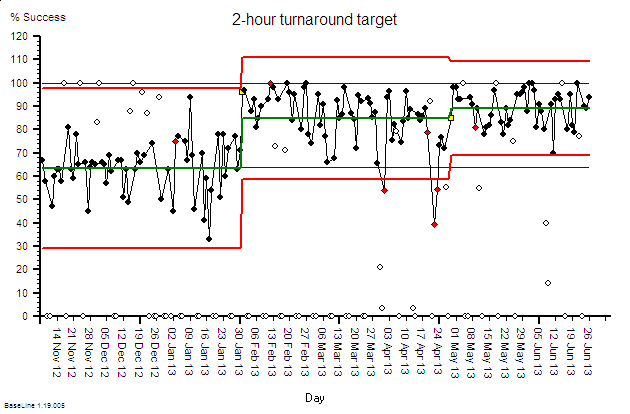Anyone with much experience of change will testify that one of the hardest parts is sustaining the hard won improvement.
The typical story is all too familiar – a big push for improvement, a dramatic improvement, congratulations and presentations then six months later it is back where it was before but worse. The cynics are feeding on the corpse of the dead change effort.
The cause of this recurrent nightmare is a simple error of omission.
Failure to complete the change sequence. Missing out the last and most important step. Step 6 – Maintain.
Regular readers may remember the story of the pharmacy project – where a sceptical department were surprised and delighted to discover that zero-cost improvement was achievable and that a win-win-win outcome was not an impossible dream.
Enough time has now passed to ask the question: “Was the improvement sustained?”
 The BaseLine© chart above shows their daily performance data on their 2-hour turnaround target for to-take-out prescriptions (TTOs) . The weekends are excluded because the weekend system is different from the weekday system. The first split in the data in Jan 2013 is when the improvement-by-design change was made. Step 4 on the 6M Design® sequence – Modify.
The BaseLine© chart above shows their daily performance data on their 2-hour turnaround target for to-take-out prescriptions (TTOs) . The weekends are excluded because the weekend system is different from the weekday system. The first split in the data in Jan 2013 is when the improvement-by-design change was made. Step 4 on the 6M Design® sequence – Modify.
There was an immediate and dramatic improvement in performance that was sustained for about six weeks – then it started to drift back. Bit by Bit. The time-series chart flags it clearly.
So what happened next?
The 12-week review happened next – and it was done by the change leader – in this case the Inspector/Designer/Educator. The review data plotted as a time-series chart revealed instability and that justified an investigation of the root cause – which was that the final and critical step had not been completed as recommended. The inner feedback loop was missing. Step 6 – Maintain was not in place.
The outer feedback loop had not been omitted. That was the responsibility of the experienced change leader.
And the effect of closing the outer-loop is clearly shown by the third segment – a restoration of stability and improved capability. The system is again delivering the improvement it was designed to deliver.
What does this lesson teach us?
The message here is that the sponsors of improvement have essential parts to play in the initiation and the maintenance of change and improvement. If they fail in their responsibility then the outcome is inevitable and predictable. Mediocrity and cynicism.
Part 1: Setting the clarity and constancy of common purpose.
Without a clear purpose then alignment, focus and effectiveness are thwarted. Purpose that changes frequently is not a purpose – it is reactive knee-jerk politics. Constancy of purpose is required because improvement takes time to achieve and to embed. There is always a lag so moving the target while the arrow is in flight is both dangerous and leads to disengagement. Establishing common ground is essential to avoiding the time-wasting discussion and negotiation that is inevitable when opinions differ – which they always do.
Part 2: Respectful challenge.
Effective change leadership requires an ability to challenge from a position of mutual respect. Telling people what to do is not leadership – it is dictatorship. Dodging the difficult conversations and passing the buck to others is not leadership – it is ineffective delegation. Asking people what they want to do is not leadership – it is abdication of responsibility. People need their leaders to challenge them and to respect them at the same time. It is not a contradiction. It is possible to do both.
And one way that a leader of change can challenge with respect is to expose the need for change; to create the context for change; and then to commit to holding those charged with change to account – including themselves. And to make it clear at the start what their expectation is as a leader – and what the consequences of disappointment are.
It is a delight to see individuals, teams, departments and organisations blossom and grow when the context of change is conducive. And it is disappointing to see them wither and shrink when the context of change is laced with cynicide – the toxic product of cynicism.
So what is the next step?
What could an aspirant change leader do to get this for themselves and their organisations?
One option is to become a Student of Improvementology® – and they can do that here.
 |
 |
 |
